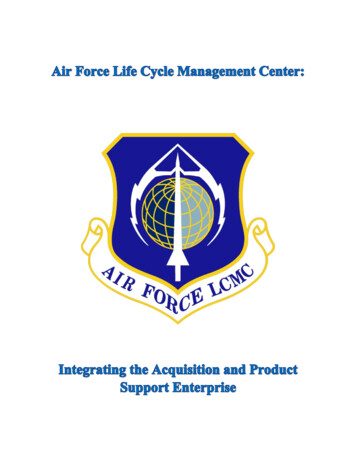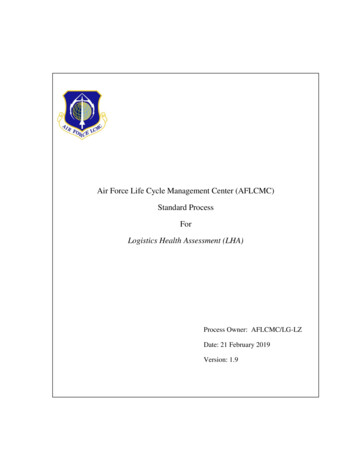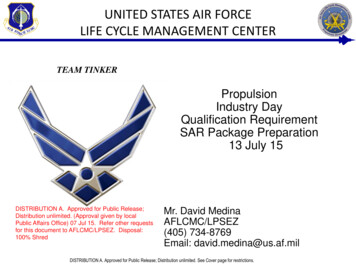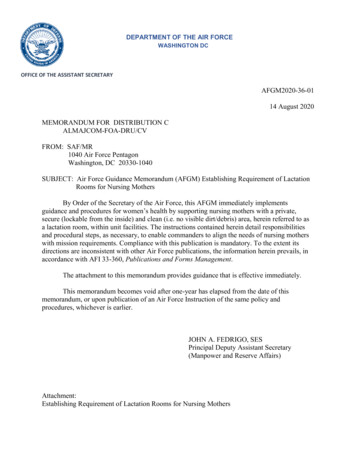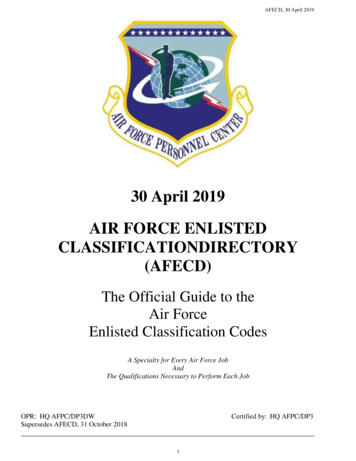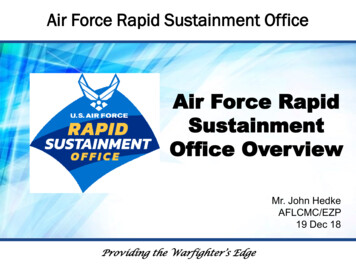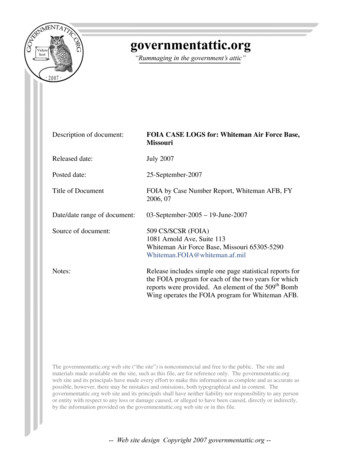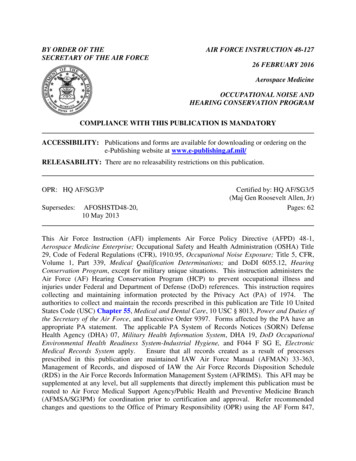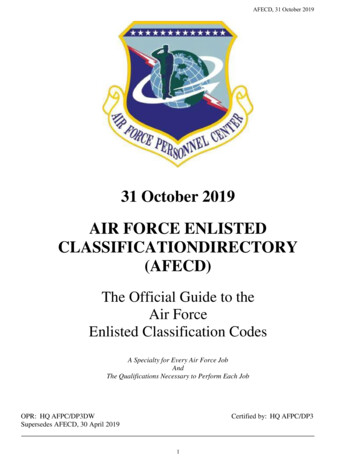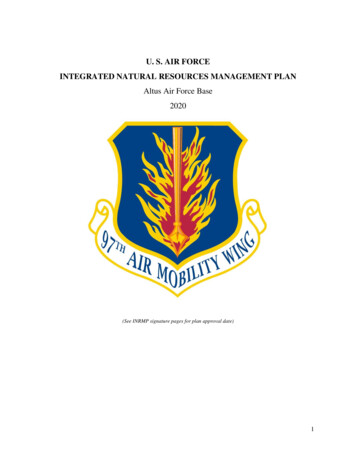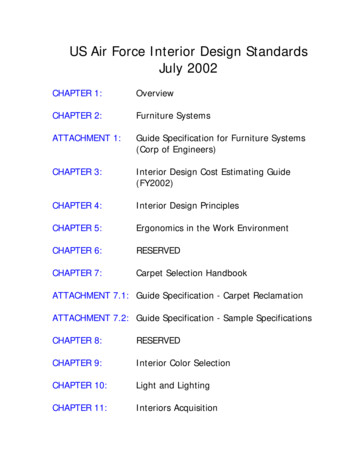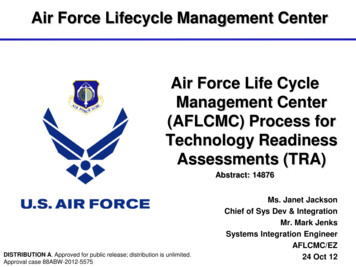
Transcription
Air Force Lifecycle Management CenterAir Force Life CycleManagement Center(AFLCMC) Process forTechnology ReadinessAssessments (TRA)Abstract: 14876DISTRIBUTION A. Approved for public release; distribution is unlimited.Approval case 88ABW-2012-5575Ms. Janet JacksonChief of Sys Dev & IntegrationMr. Mark JenksSystems Integration EngineerAFLCMC/EZ24 Oct 12
Contents PurposeBackgroundChallengesAFLCMC TRA Process–––––Roles and ResponsibilitiesMDAP SME SelectionMDAP Process and TimelineNon-MDAP TailoringRecommended TRAs Tools and References Lessons learned2
Purpose Raise awareness of the Air Force LifeCycle Management Center newlyestablished TRA process Promulgate the standardized TRAprocess across AFLCMC portfolios andindustry3
Background AF PSR - 2010– Lead by SAF/AQRE, designed to integrate AF reviews withOSD reviews for MDAPs– Established leadership, timelines, decision points andprocess for AF TRAs– Eliminated in Dec 2011 OSD Streamlining - May 2011– Eliminated mandatory TRA at MS C– Eliminated independent team lead– Established Program Manager as TRA lead AFMC 5 Center Construct - Jul 2012– Reduced number of centers in AFMC to five– Eliminated and consolidated engineering staff functions4
ChallengesAcquisition Landscape Changed Lots of moving parts Limited AF role in supportingTRA Organizational landscapechanged– Single EZ organization for lifecyclemanagementBuild Integrated Team AcrossEnterprise Familiarity, Trust ,– Geographically separated unitsCooperationwith no dedicated local SMEsBuild Common, EfficientavailableEnterprise Processes Max Value Team Solutions– Different culture at each location Technical risk often not identified COTS solution maturitypresumed, not assessedAFLCMC/EN-EZRoadmapEffective, Affordable, Ontime results Maximizecapability output usingseamless support fromacross the enterpriseImperative to Standardize TRA Process and Expectations5
AFLCMC TRA Process TRA Process developed jointly with SMEs from 6main locations– Followed rigorous development process– Became chapter of AFLCMC Process Guide Book Adds implementation details to existing OSD andAF instructions - no change to policy Process covers:MultilocationTeam–––––Overview of existing policyRoles and responsibilitiesMDAP §2366b TRA processRequesting SMEsGuidance for non-MDAPs,including MAIS ftedAnyone cansuggest a amIssuesFeedback6
Roles and Responsibilities Process Owner: AFLCMC/EZID– Maintain process, provide training and TRA SMEs responds to programs– Facilitate identifying SMEs Program Manager or Chief Engineer– Lead the team to conduct and report TRAs– Determine if and when to conduct a tailored TRA to identify technical riskat other milestones and key decision points– Establish technology maturation and mitigation plans– Provide program technical information to independent SME teams Independent SME team– Review the performance, technical requirements, and design of the system– Review critical technologies and recommend additions or deletions– Provide findings and conclusions for the TRA report Prime Contractor– Provide system briefings to independent team (MDAPs)– Provide artifacts documenting relevant tests of critical technologies7
MDAP SME Selection Program Manager responsible for identifyingindependent SMEs IAW OSD policy memo "Independent" defined as outside programmanager chain of command SME can be obtained from multiple sources:–––––Within PEO directorateOther PEO directorateAFLCMC/EZ technical expertsAFRL or other AF unitsOther services, academia, etc.8
MDAP Process and Timeline12 - 24 Monthsbef ore milestonePM initiatesTRAPM WritesTRA PlanTRA PlanApproved byPEO, CAEandASD(R&E)PM CollectsData forAssessmentConductTRADocumentTRA results6 Months bef oremilestoneIndependentTeamIdentified &approved byPEO & CAECTsIdentifiedReportResults toASD(R&E)2366bCertification2 Months bef oremilestoneSchedule dependent on program complexity and contract strategy9
Non-MDAP Tailoring PM and CE determinewhen TRA neededTRA Plan approvedby PEO, SAF/AQ,and ASD(R&E)Independent SMEsapproved by PEO,SAF/AQ, andASD(R&E) PM may acquireSMEs as needed,independence notrequired Begin 6 monthsprior need date Plan accomplishedsolely at the PMlevel or between thePM and PEOPM conducts TRASMEs assess CT listand PMs riskreduction adequacyPM prepares TRAreport w/ SMEfindings; submitthrough PEO to CAEto ASD(R&E) PM (or CE) directsSME review toprovide neededinformation The PM is responsible forthe TRA, but will normallyassign actual conduct tothe CE PM determinescapture anddocumentationformat andcontent10
Recommended TRAs and TRLsAMaterial Solution AnalysisBTechnologyDevelopmentCEngineering &ManufacturingDevelopmentFRPProduction &DeploymentMRL 1MRL 2MRL 3MRL 4MRL 5MRL 6MRL 7MRL 8MRL 9MRL 10Basic roof ofConceptDevelopedManufacturingProcessesIn LabEnvironmentComponentsIn ProductionRelevantEnvironmentSystem orSubsystemIn ProductionRelevantEnvironmentSystem orSubsystemIn ProductionRepresentativeEnvironmentPilot LineDemonstratedReady forLRIPLRIPDemonstratedReady forFRPFRPDemonstratedLean ProductionPractices inplaceTRL 1BasicPrinciplesObservedTRL 2ConceptDevisedTRL 3ProofofConceptTRL 8SystemQualifiedTRL 9MissionProvenTRL 4TRL 5Breadboard Breadboardinin RepLabEnvironTRL 6Prototypein RepEnvironTRL 7Prototypein OperationalEnvironmentRecommended times to consider tailored TRAs: Before MS A, B, & C Prior to EMD RFP release to help determine development strategy Prior to final CDD approvalTailored TRA Approach Identifies Risks11
Tools & References DoD TRA Deskbook, July 2009The 2011 DoD TRA Guidance supersedes the TRA Deskbook,but the Deskbook contains additional details useful foridentifying and assessing critical technologies AFMC/A2/5 Memorandum on AFMC Technology ReadinessAssessment Independent Review Panel Staffing Process,19 January 2011This optional process is for requesting SME support outside ofAFLCMC DAG section 4.3.2.4.2.4 (TRA)(as of 3 September 2011) DAU Module CLE 021 Technology Readiness Assessment AFRL Technology Maturity Calculator, version 3.6.0 Risk Identification: Integration and –ilities (RI3) tool version3.0.112
Lessons Learned Source Selection– Evaluation factor for award– Evaluate all proposed systems COTS products adapted to military environment needmaturity assessed Integrate MRA, TRA, and RI3 results for a complete picture Technology maturity should feed into risk managementprocess Geographic separation drives need for some independencefrom home office TRAs apply to more than just MDAPs and MS B A tailored TRA approach is more manageableTRAs Provide Valuable Information For Program Decisions13
Summary AFLCMC TRA Process established– Process shaped by changes to the TRAprocess and organization– Standardized process improves execution andefficiency for geographically separated units TRA is essential to making informedprogram decisions as well as earlyidentification of technology mature risks14
AFLCMC TRA Process established –Process shaped by changes to the TRA process and organization –Standardized process improves execution and efficiency for geographically separated units TRA is essential to making informed program decisions as well as early identification of
